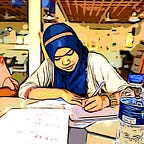Daenggi: A Must Have Hair Accessory of the Past
In the past, ancient Korean females styled their long braided hairs in different ways. It started during the Baekje era where Confucianism beliefs didn’t allow them to cut their hair as it was seen as a gift from their parents. Of the many accessories they used, the daenggi was one of the most popular and commonly used by women of all ages. It is a cloth ribbon that is tied at the end of the hair and is styled differently between married and unmarried women. The design of the daenggi also varied based on age, status and purpose.
Married women usually sectioned their hair into two plaits and secured them at the top of their head with a daenggi. But unmarried girls used the daenggi at the end of their single braided hair.
Young female children with short hair wore a daenggi known as the doturank daenggi. It is also short and used to secure their hair at the back. But slightly older girls wore a daenggi that was known as the malttuk daenggi, along with a baessi daenggi. The baessi daenggi is unlike the usual cloth ribbon. It has thinner strings at the end and a decorative centerpiece in the middle. The centerpiece is either a square or a circular silk that is adorned with stuffed coloured cloth, beads and stones. In English, baessi translates to a pit of a pear, and the shape of this was the inspiration behind its name. It is the first jewelry that was used by girls and meant to prevent bad luck and illness. This daenggi’s strings on the sides are used to tie the accessory under the hair at the bottom or braid it into the plait. The centerpiece is placed at the top after parting the hair, along with a bottom braid that is secured with a malttuk daenggi. A significant detail in this maltukk daenggi is its rectangular end.
Unmarried girls used the jebiburi daenggi that had pointed triangular ends. The shape of the daenggi’s ends were also the reason behind its name. It is designed with prints of animals, different characters and embroidered flowers. This daenggi was used by unmarried princesses as well, when securing their long braids. But unlike the ordinary ones, these were designed with gold or silver patterns as a mark of royalty and status.
For brides, the daenggi that is used to style their hair is longer and combined with a golden binyeo and a doturak daenggi. The bridal daenggi is also known as the deurim daenggi and includes beads and pearls attached at the end. It is 120cm long and 5cm wide. When wearing it, the daenggi is bound once or twice around the binyeo and the remaining ends are placed at the front of both shoulders. This is how the daenggi’s name was generated as well.
The apdaenggi is a ceremonial daenggi also worn by brides along with the doturak daenggi and the wedding dress. But on other ceremonial occasions this daenggi is worn alone. The material of this daenggi is black silk with golden patterns embossed on it. These patterns range from the ten immortal symbols of sipjangsaengmun, lotus blossoms and wave patterns known as supamun.
The doturak daenggi is attached from the nape of the neck down at the back as a part of the traditional bridal outfit. This accessory is of two colours including black and red and has printed patterns of clouds, pomegranates, cranes and sipjangsaengmun. This daenggi is made of satin and is split in the middle. When styling the hair with this daenggi, the bride’s hair is arranged into a sushik hairstyle that includes the daenggis, the binyeo and a jokduri or the hwagwan crown.
Tteoguji daenggi was used when securing the tteoguji that was a carved and painted wooden structure used in styling the eoyeo mori. It was used to create the keun mori hairstyle and attached to the wig. The tteoguji daenggi helped in maintaining the sophisticated look of this hairstyle. But this style was used only during special ceremonies and worn by the queen, royal concubines and consorts, and high ranked court ladies.
Jjok daenggi was used to secure the braided chignon of a jjokjin meori that married women commonly wore. But the colour and material of this was designed with varied based on age, status and occasion. Young women wore a jjok daenggi that was red, while older women styled their hair with black ones. For funerals, this daenggi was worn in white.
Court ladies or gungnyeo wore a daenggi called negadak daenggi and patip daenggi. These were used when styling the saeng mori. Here the daenggi and the sections in the hairstyle also represented the divisions that the court ladies were assigned to. And so, wearing a negadak daenggi meant that the hair was divided into 4 parts and that represented their department. The patip daenggi was used by musuri, who were the maids with the lowest ranks in the palace. They also styled their hair with the saeng mori and were assigned most of the rough work in the palace.
For more interesting content on Korean traditions, culture and fashion visit Heol Korea!
